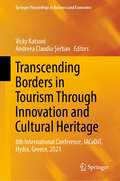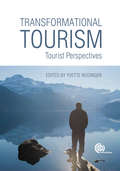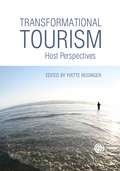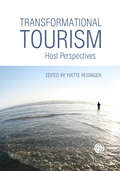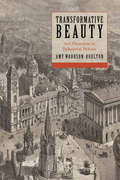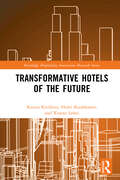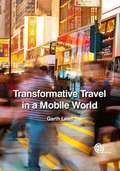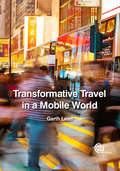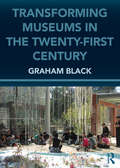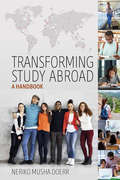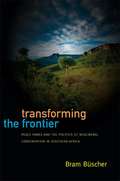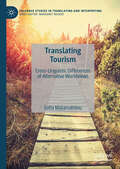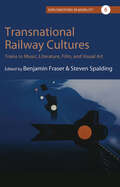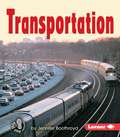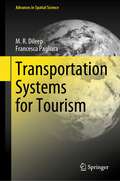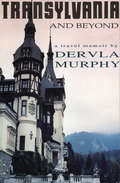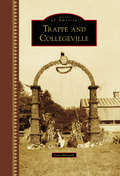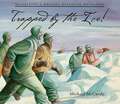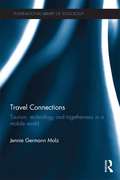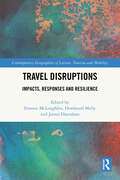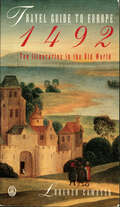- Table View
- List View
Transcending Borders in Tourism Through Innovation and Cultural Heritage: 8th International Conference, IACuDiT, Hydra, Greece, 2021 (Springer Proceedings in Business and Economics)
by Vicky Katsoni Andreea Claudia ŞerbanThis book features the proceedings of the 8th International Conference of the International Association of Cultural and Digital Tourism (IACuDiT). Held on the Hydra Island in Greece in September 2021, the conference's lead theme was “Transcending Borders in Tourism through Innovation and Cultural Heritage”.Highlighting the contributions made by numerous writers to the advancement of tourism research, this book presents a critical academic discourse evolving tourism products and services. It also deals with strategies that help stimulate economic innovation and growth, and promote knowledge transfer. Selected chapters also deal with innovation, creativity, and change management in all aspects of tourism, culture, and heritage. A crucial focus is also placed on embracing ICT as a powerful development tool along with strategies and campaigns for smart tourism. It offers numerous examples from the whole spectrum of cultural and heritage tourism, including art, innovations in museum interpretation and collections management, cross-cultural visions, gastronomy, film tourism, dark tourism, sports tourism, and wine tourism.
Transformational Tourism
by Stephen Wearing Annette Pritchard Nigel Morgan Omar Moufakkir Ian Kelly Melanie Smith Ulrike Gretzel Lorraine Brown Yvette Reisinger Simone Grabowski Patrick Holladay Paul Heintzman Jennifer Erderly Dr Mark Kanning Kylie Radel Eric Brymer Lauren Ponder Adrian Deville Agnes Nowaczek Yoon Jong LeeTransformational Tourism deals with the important issue of how travel and tourism can change human behaviour and have a positive impact on the world. The book focuses on human development in a world dominated by post-9/11 security and political challenges, economic and financial collapses, and environmental threats. It identifies various types of tourism that can transform human beings, such as educational, volunteer, survival, community-based, eco, farm, extreme, religious, spiritual, wellness, and mission tourism.
Transformational Tourism
by Stephen Wearing Omar Moufakkir Melanie Smith Anya Diekmann Michael Michael Yvette Reisinger Keith Keith Dr Mark Kanning Eric Brymer Adrian Deville Isaac Isaac Greg Ashworth Bianca Bianca Ignacio Ignacio Sagar SagarTransformational Tourism deals with the important issue of how travel and tourism can change human behaviour and have a positive impact on the world. The book focuses on human development in a world dominated by post-9/11 security and political challenges, economic and financial collapses, as well as environmental threats; it identifies various types of tourism that can transform human beings, such as educational, volunteer, survival, community-based, eco, farm, extreme, religious, spiritual, wellness, and mission tourism.
Transformational Tourism: Host Perspectives
by Yvette ReisingerTransformational Tourism deals with the important issue of how travel and tourism can change human behaviour and have a positive impact on the world. The book focuses on human development in a world dominated by post-9/11 security and political challenges, economic and financial collapses, as well as environmental threats; it identifies various types of tourism that can transform human beings, such as educational, volunteer, survival, community-based, eco, farm, extreme, religious, spiritual, wellness, and mission tourism.
Transformative Beauty: Art Museums in Industrial Britain
by Amy Woodson-BoultonWhy did British industrial cities build art museums? By exploring the histories of the municipal art museums in Birmingham, Liverpool, and Manchester, Transformative Beauty examines the underlying logic of the Victorian art museum movement. These museums attempted to create a space free from the moral and physical ugliness of industrial capitalism. Deeply engaged with the social criticism of John Ruskin, reformers created a new, prominent urban institution, a domesticated public space that not only aimed to provide refuge from the corrosive effects of industrial society but also provided a remarkably unified secular alternative to traditional religion. Woodson-Boulton raises provocative questions about the meaning and use of art in relation to artistic practice, urban development, social justice, education, and class. In today's context of global austerity and shrinking government support of public cultural institutions, this book is a timely consideration of arts policy and purposes in modern society.
Transformative Hotels of the Future (Routledge Hospitality Innovation Research Series)
by Henri Kuokkanen Ksenia Kirillova Xinran LehtoThis timely and innovative book offers an inspirational and thought-provoking journey into the future world of hospitality by conceptualizing an innovative future where hotels transcend traditional boundaries and evolve into dynamic hubs of innovation, environmental stewardship, community engagement, and personal growth at the guest, employee, and local resident level.Written to captivate not just industry specialists but also academia and general enthusiasts, this book presents a stimulating exploration of the transformative effects hotels can have on individuals, destination communities, and society at large.The book has three parts, with each part combining current trends with speculative future advancements, aiming to inspire and challenge entrepreneurs, educators, and researchers to think of hotel innovation beyond the constraints of today's technology and societal norms. The first part focuses on the individual-level transformation that hotels can instigate, while the second part delves into the influential role of hotels as agents of community-wide transformation. The final part examines the role of hotels in driving system-wide transformation in environmental and social sustainability and ecological conservation by developing a renewed purpose for them. This groundbreaking book conceives the transformative hotels of the future and provides a futuristic perspective focusing on the fundamental effects that hotels can have on individuals, the society, and the planet.The book aims to challenge and inspire hoteliers, hospitality students, and scholars to think of hotels under a new light.
Transformative Travel in a Mobile World
by Garth LeanThis book presents the re-theorisation of travel and transformation. It explores the factors that influence the behaviours of a traveller, how these become entwined in experiences and how travel experiences continue on a traveller's return. It uses the notion of transformation to redevelop the temporal and spatial boundaries of physical travel, develop a model for unpacking transformation and to look at new methods in the exploration of travel research.
Transformative Travel in a Mobile World
by Garth LeanThis book presents the re-theorisation of travel and transformation. It explores the factors that influence the behaviours of a traveller, how these become entwined in experiences and how travel experiences continue on a traveller’s return. It uses the notion of transformation to redevelop the temporal and spatial boundaries of physical travel, develop a model for unpacking transformation and to look at new methods in the exploration of travel research.
Transforming Museums in the Twenty-first Century
by Graham BlackIn his book, Graham Black argues that museums must transform themselves if they are to remain relevant to 21st century audiences – and this root and branch change would be necessary whether or not museums faced a funding crisis. It is the result of the impact of new technologies and the rapid societal developments that we are all a part of, and applies not just to museums but to all arts bodies and to other agents of mass communication. Through comment, practical examples and truly inspirational case studies, this book allows the reader to build a picture of the transformed 21st century museum in practice. Such a museum is focused on developing its audiences as regular users. It is committed to participation and collaboration. It brings together on-site, online and mobile provision and, through social media, builds meaningful relationships with its users. It is not restricted by its walls or opening hours, but reaches outwards in partnership with its communities and with other agencies, including schools. It is a haven for families learning together. And at its heart lies prolonged user engagement with collections, and the conversations and dialogues that these inspire. The book is filled to the brim with practical examples. It features: an introduction that focuses on the challenges that face museums in the 21st century an analysis of population trends and their likely impact on museums boxes showing ideas, models and planning suggestions to guide development examples and case studies illustrating practice in both large and small museums an up-to-date bibliography of landmark research, including numerous websites Sitting alongside Graham Black’s previous book, The Engaging Museum, we now have a clear vision of a museum of the future that engages, stimulates and inspires the publics it serves, and plays an active role in promoting tolerance and understanding within and between communities.
Transforming Study Abroad: A Handbook
by Neriko Musha DoerrWritten for study abroad practitioners, this book introduces theoretical understandings of key study abroad terms including “the global/national,” “culture,” “native speaker,” “immersion,” and “host society.” Building theories on these notions with perspectives from cultural anthropology, political science, educational studies, linguistics, and narrative studies, it suggests ways to incorporate them in study abroad practices. Through attention to daily activities via the concept of immersion, it reframes study abroad not as an encounter with cultural others but as an occasion to analyze constructions of “differences” in daily life, backgrounded by structural arrangements.
Transforming the Frontier: Peace Parks and the Politics of Neoliberal Conservation in Southern Africa
by Bram BüscherInternational peace parks--transnational conservation areas established and managed by two or more countries--have become a popular way of protecting biodiversity while promoting international cooperation and regional development. In Transforming the Frontier, Bram Büscher shows how cross-border conservation neatly reflects the neoliberal political economy in which it developed. Based on extensive research in southern Africa with the Maloti-Drakensberg Transfrontier Conservation and Development Project, Büscher explains how the successful promotion of transfrontier conservation as a "win-win" solution happens not only in spite of troubling contradictions and problems, but indeed because of them. This is what he refers to as the "politics of neoliberal conservation," which receives its strength from effectively combining strategies of consensus, antipolitics, and marketing. Drawing on long-term, multilevel ethnographic research, Büscher argues that transfrontier conservation projects are not as concerned with on-the-ground development as they are purported to be. Instead, they are reframing environmental protection and sustainable development to fit an increasingly contradictory world order.
Transit Tourism: The Iconic Art and Design of 22 Subway Systems Around the World
by David SeltzerIn Transit Tourism: The Iconic Art and Design of 22 Subway Systems around the World, readers embark on a visual journey through the world's bustling subway systems, where each station tells a story of its city's soul. From the ornate elegance of Moscow's stations to the sleek minimalism of Tokyo's, this illustrated collection of travel essays explores 22 urban metros, revealing how their architecture, art, and design reflect the unique character and culture of each metropolis. Whether urban explorers, design aficionados, or simply curious about the hidden narratives beneath our cities, readers will encounter a fresh perspective on the subterranean worlds that shape our urban landscapes.Key Features:Visual culture showcase: Explore architecture, art installations, and graphic design.Unique book design: Each chapter mimics a subway line, with color-coded sections and Museo typeface inspired by timetable brochures.Entertaining narrative: Travel essays written from a tour guide&’s viewpoint for a passenger's perspective, blending humor and observation.Global scope: Covers major systems in North America, Europe, and Asia, appealing to travelers and urban enthusiasts alike.Subway system ratings: Each chapter concludes with a unique token ranking system, evaluating subway systems on convenience, design quality, and personality, providing readers with an assessment for planning their transit adventures. Uncover the fascinating stories beneath your feet with Transit Tourism: The Iconic Art and Design of 22 Subway Systems around the World, a captivating exploration of how subways shape and define the cities we love.
Transit of Venus
by Julian EvansJulian Evans won a host of awards for this smart, funny, and thoughtful travelogue through the South Pacific islands. Evans was raised in Australia, but moved to England as a teenager, and forever longed to return to the Pacific of his childhood. He sails on a freighter from Australia to cross the Pacific, stopping at a series of ever more remote islands. Along the way he discusses the politics, history, and culture of the Pacific Islanders and the Europeans with whom they so uneasily co-exist. English, not American, spelling and punctuation; also dialect here and there
Translating Tourism: Cross-Linguistic Differences of Alternative Worldviews (Palgrave Studies in Translating and Interpreting)
by Sofia MalamatidouThis book provides a large-scale empirical multilingual study of crosslinguistic differences in the language of destination promotion. The book explores how tourism texts are negotiated in translation, and how the translated texts reflect and reconcile different worldviews, that of the destination population and that of the tourist. Using the 2-million-word TrAIL (Tourism Across and & In-between Languages) corpus, which includes examples from official tourism websites in English, French, Greek, and Russian as well as translations between these languages, the author explores the differences in the key linguistic means used in destination promotion and what these linguistic choices can tell us about how these societies view the world around them differently. The book’s interdisciplinary focus makes it relevant to not only practising translators, but also students and scholars interested in issues surrounding tourism, promotion, and translation, as well as destination promoters who want to better understand the role that language and translation play in tourism promotion.
Transnational Railway Cultures: Trains in Music, Literature, Film, and Visual Art (Explorations in Mobility #6)
by Benjamin Fraser Steven SpaldingSince the advent of train travel, railways have compressed space and crossed national boundaries to become transnational icons, evoking hope, dread, progress, or obsolescence in different cultural domains. Spanning five continents and a diverse range of contexts, this collection offers an unprecedentedly broad survey of global representations of trains. From experimental novels to Hollywood blockbusters, the works studied here chart fascinating routes across a remarkably varied cultural landscape.
Transportation (First Step Nonfiction)
by Jennifer BoothroydThis social studies series offers early emergent readers a comparison of how people live in their local communities. By focusing on everyday topics, students will be encouraged to compare and contrast their own experiences.
Transportation Systems for Tourism (Advances in Spatial Science)
by Francesca Pagliara M. R. DileepThis textbook provides a comprehensive learning resource material for tourism transportation. Exploring the interrelationship between transport and tourism, it demonstrates how different types of transportation systems interact and are combined within the tourism destination framework. It addresses topics such as the geographical aspects of tourism transportation, technological advances in transportation, public transportation in tourism, drive tourism, recreational transportation, and various forms of tourism, including car, rail, coach, water, cycling, and space tourism. Readers will also learn about sustainability aspects, consumer behavior, and tourist behavior modelling. The book offers a valuable asset for graduate as well as master degree students in regional and spatial science, transportation engineering, and tourism and transportation economics, as well as for professionals in the travel, tourism, transport, and hospitality industries who are interested in the link between tourism and transportation, its benefits and impacts. Tourist destinations can strategically use this learning resource to gain a better understanding of the leisure and recreational aspects of the transportation system and consequently boost their appeal to tourists.
Transylvania and Beyond
by Dervla MurphyFrom childhood Dervla Murphy harboured a secret desire to visit Rumania. Two weeks after the fall of Ceausescu her dream was realized. This is the story of her voyage.
Transylvania and Beyond
by Dervla Murphy"While world attention was focused on Bucharest after the execution of Ceausescu, acclaimed travel writer Dervla Murphy spent eight months in Transylvania sharing the everyday lives of ordinary Romanians. Upon her arrival soon after the revolution, Murphy found a nation both exhilarated and bewildered; unlike other East Europeans, the Romanians had had no warning that they were about to be liberated. During a return visit in 1991, she noticed a profound change in the national mood. " "Candid and eye-opening, Transylvania and Beyond describes a journey on two levels - wandering through the remotest corners of the Carpathians, on foot or by bicycle, and into the often daunting mental terrain of a post-Communist society where nothing is quite as it seems. " "Murphy was overwhelmed by the warmth of the hospitality she received. In urban blocs, small towns and traditional villages she spent time with teachers, factory-workers, writers, farmers, professors, engineers, vets, army officers, shepherds, students and doctors. As they revealed their hopes, fears and prejudices to her, Dervla gained some unexpected insights into what she calls "one of Europe's least European countries. ""--BOOK JACKET. Title Summary field provided by Blackwell North America, Inc. All Rights Reserved
Transylvania and Beyond: A Travel Memoir
by Dervla MurphyThe intrepid explorer’s journey to Romania. Dervla Murphy spent eight months in Transylvania - and beyond - sharing the everyday lives of ordinary Rumanians. Her book describes a journey on two levels - wandering through the remotest corners of the Carpathians, on foot or by bicycle, and into the often daunting mental terrain of a post-Communist society where nothing was quite what it seemed.
Trappe and Collegeville (Images of America)
by Lisa MinardiLocated in the scenic Perkiomen Valley, the adjacent boroughs of Trappe and Collegeville have a rich and fascinating history. Trappe was founded in 1717 by German immigrant Jacob Schrack Sr., who ran a tavern known as the Trap, after which the village was named. Its most famous early residents were Lutheran patriarch Henry Melchior Muhlenberg and his sons Peter, a Revolutionary War general, and Frederick, first speaker of the US House of Representatives. Collegeville, initially known as Freeland, developed primarily in the 1800s following the completion of the Perkiomen Bridge in 1799. It was named after several early colleges, including Freeland Seminary, established in 1848, and the Pennsylvania Female College, established in 1851. These institutions were succeeded by Ursinus College in 1869. A pioneer in women’s education, Ursinus became coeducational in 1880. Trappe and Collegeville were formally incorporated as separate boroughs in 1896.
Trapped by the Ice! Shackleton's Amazing Antarctic Adventure: Shackleton's Amazing Antarctic Adventure
by Michael McCurdyDescribes the events of the 1914 Shackleton Antarctic expedition when, after being trapped in a frozen sea for nine months, the expedition ship, the Endurance, was finally crushed and Shackleton and his men made the very long and perilous journey across ice and stormy seas to reach inhabited land.
Travel Connections: Tourism, Technology and Togetherness in a Mobile World (International Library of Sociology)
by Jennie Germann MolzLiving in a world that is increasingly ‘on the move’ means that many of us now rely on mobile devices, social media, and networking technologies to coordinate togetherness with our social networks even when we are apart. Nowhere is this phenomenon more evident than in the emerging practices of ‘interactive travel’. Today’s travellers are more likely than ever to pack a laptop or a mobile phone and to use these devices to stay in touch with friends and family members – as well as to connect with strangers and other travellers – while they are on the road. New practices such as location-aware navigating, travel blogging, flashpacking and Couchsurfing now shape the way travellers engage with each other, with their social networks, and with the world around them. Travel Connections prompts a rethinking of the key paradigms in tourism studies in the digital age. Interactive travel calls into question longstanding tourism concepts such as landscape, the tourist gaze, hospitality, authenticity and escape. The book proposes a range of new concepts to describe the way tourists inhabit the world and engage with their social networks in the twenty-first century: smart tourism, the mediated gaze, mobile conviviality, re-enchantment and embrace. Based on intensive fieldwork with interactive travellers, Travel Connections offers a detailed account of this emerging phenomenon and uncovers the new forms of mediated and face-to-face togetherness that become possible in a mobile world. This book will be of interest to students and scholars of sociology, tourism and hospitality, new media, cosmopolitanism studies, mobility studies and cultural studies.
Travel Disruptions: Impacts, Responses and Resilience (Contemporary Geographies of Leisure, Tourism and Mobility)
by James Hanrahan Emmet McLoughlin Domhnall MellyThis timely and pivotal volume explores the nexus of a wide range of travel disruptions and their multifaceted implications on the global travel and tourism industry.As the global travel and tourism industry struggles with an increasingly unpredictable landscape marked by natural disasters, health crises, geopolitical upheavals, and societal transformations, comprehensive insights and practical strategies are needed to help navigate these challenges. Comprising 13 specifically commissioned chapters authored by global experts in the field, this insightful and richly illustrated book therefore explores the interplay of unique factors influencing travel behaviour, policy responses, and the industry’s overall resilience. With a multidisciplinary focus and international case studies throughout, the book examines innovative strategies for building resilience, post-disruption recovery mechanisms, and crisis communication protocols, as well as exploring the various social, cultural, and ethical implications often linked with economic growth and cultural preservation. It provides a global understanding of the ever-evolving landscape of travel disruptions, the psychological nuances that tend to guide traveller choices and a comprehensive assessment of policy responses, governance strategies, and stakeholder collaborations that aim to strengthen resilience in the industry, thus helping to ensure sustainable growth in the future.This book is a pivotal resource for academics, researchers, industry professionals, and policymakers concerned with the ever-evolving nature of travel and tourism, going beyond theoretical discourse.
Travel Guide to Europe, 1492: Ten Itineraries in the Old World
by Lorenzo CamussoOn the eve of the five hundredth anniversary of the discovery of the Americas, it bears remembering that in 1492, as Columbus was making his historic voyage, Europe was flourishing, at the very height of the Renaissance that transformed a continent. In art, politics, commerce, and society, the medieval world had given way to the modern era. But what was Europe really like then? What did London, Paris, Rome, and the other great centers of culture actually look like, and what was it like to travel from one to the other when the horse and the sailing ship were the most expeditious means available? How long would a typical journey take? Where would one stay and what could one eat along the way? And whom might one expect to meet? Both kings and pilgrims, to be sure.In Travel Guide to Europe 1492, the noted Italian historian Lorenzo Camusso offers modern-day readers and would-be adventurers ten itineraries for trips commonly taken in both the near and far reaches of fifteenth-century Europe. Whether Camusso's wayfarer is an ambitious young banker on the road From Florence to Bruges;the great painter Albrecht Rurer on his way from Nurember to Venice, a shipbuilder whose highly prized craft takes him from Seville to Antwerp via Barcelona, Beaune, and Paris; or a lonely pilgrim wandering from Vezelay to far-off Santiago de Compostela, he offers a vivid account of what such a journey would be like--the sights, sounds, perils, and pleasures--and in so doing he renders the very fabric of day-to-day life during this momentous ear in Europe's history.
